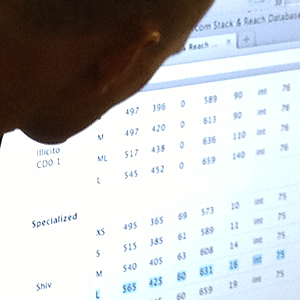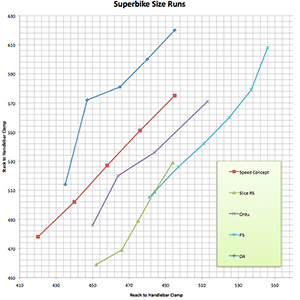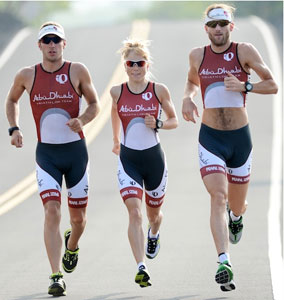Maik Twelsiek Goes Clockwise

I got a ping from Maik Twelsiek, just after the news of the abrupt folding of the Abu Dhabi Tri Team. This was the second time for Maik, who was a member of the now defunct Commerzbank team and when these soup-to-nuts teams collapse your entire sponsorship income craters. On the plus side, this was the ideal time — thought Maik — to dial in his position and contact points first, rather than to unbox a bike his team sends, and then figure out a way to make it work.
You might think this is what pros do — choose products that match their needs. In fact, typical age group customers are much more likely to pick product based on what works for them. Pros are the least likely to select product based on preference. Let me rephrase. They are the least likely to choose a product based on technical preference. Rather, as a rule, in my experience, most (not all, but most) pros tend to choose sponsorships primarily based on financial preference. That’s not bad. It’s expedient. It’s the way it is. But it’s regrettable.
Maik decided to buck that trend, I think because of the stridently random nature of the equipment you end up with when you sign on with a team. You wear the team’s shoes, ride the team’s saddle, aerobars, apparel, swim in the team’s wetsuits. This flies in the face of what we all learn, which is, “buy the [thing] that fits.” Maik hit on the idea of using stuff that works for him, which is to say, the professional began to think like the amateur which, in this case, was the very best thing he could do.
As it happened, Maik called just as we were about to commence a week of bike fit workshops, training the retailers who fit you all to your bikes, and it seemed an expedient show-and-tell opportunity for our workshop attendees. Maik showed up last Thursday and we set about fitting him.

Maik’s prior bikes were provided by Storck and Scott, sponsors of the Abu Dhabi and Commerzbank teams respectively. He brought along his Scott Plasma Premium for comparison. The bike had on it older style Profile Design aerobars and a Fizik Arione Tri 2. I replicated the equipment fairly closely to begin the fitting process, except I placed on the fit bike both a new Profile Design T3 + Carbon aerobar as well as a Zipp Vuka Alumina Clip. These were both comfort improvements over what he’s been riding. The thing about Maik, he’s a bigger guy, fairly wide shoulders, and he needs an armrest width that is in excess of that normally available on a lot of aerobars. If he ends up riding Zipp bars, for example, he’d require the Vuka Pad Wing Extension.
This might raise an eyebrow for some readers, who assume that pros (being pros) work very hard at getting their elbows close together. No. They don’t. They work very hard at getting comfortable. Just like you. Maik showed me something I’ve never seen before: a power file from an Ironman that showed an average power with the first digit being a 3. When you ride 3-something-something watts for 112 miles you’ve got to do it comfortably, and this was one of this 2-time Ironman champ’s concerns.

I propped him aboard a Purely Custom fit bike, one of three different bikes we have at The Compound for fitting riders. This bike adjusts rider positions very quickly, and it became apparent to me that we had a problem. Maik was sitting too far back on the saddle (see the image above). I don’t mind if a rider chooses to sit back on the saddle, or choose a rearward seat angle, for the “right” reasons, but what’s most typical when I see this is what we term a “contact point” problem. Maik was just not comfortable on this saddle. He was protecting himself against the saddle. His entire bike position was driven by the saddle. We were not going to be able to generate good fit coordinates for him until we fixed this contact point problem. (In the image below, Slowman demonstrates male pattern balding to the camera, and a preferred posture aboard a tri saddle to Maik.)
I moved him over to another fit bike, made by Exit Cycling, not because this fit bike was better or worse, rather because I’ve got a very nifty widget on my Exit fit bikes called a SwtichIt, made by Paul Swift at BikeFit. I bring Paul in to teach pedal/shoe interface at our workshops, and we sell a lot of his SwitchIts to high volume stores that sell a lot of aftermarket saddles. The SwitchIt allows me to execute a saddle change and nose tilt adjustment in about 10 seconds. No hyperbole there. 10 seconds.
I placed Maik aboard the Exit Cycling bike in a position that would pretty much require him to get off the back of the saddle. Now, nothing against the Fizik saddle he’d been riding. This exercise is like Match.com. If you’re underside likes walks on the beach, but the saddle you’re perched aboard prefers a cabin in the mountains, there’s just no match there. You need a walks-on-the-beach saddle.

We tried, ISM, no go. We tried the new Cobb Gen2, which is a favorite of Jordan Rapp, and this was the best one going for Maik so far. I’ve got the Gen2 on my road race bike. Then we stuck a Profile Design TriStryke on there and, bingo, this was the winner. Best saddle of all of them for Maik. We’ve got a match. Maik’s entire posture aboard the bike changed. Now we were in business.
Just, as a side note: This entire saddle selection process took maybe 15 minutes. We tried at least 8 saddles. Some people think they’re getting short changed when a fit process does not take 2 or 3 hours. Trying 8 saddles is 1 hour out of a 2 hour fit, if you do not have the right tooling. Yes, it’s expensive to buy the right tools, but, when I work on fit bikes like those by Purely Custom, or the fantastical technology you sit aboard during The Guru Experience, I just feel that my time and yours is worth more than the investment in tools. Which is why I have the technology in my studio that I do. You’ll have to pardon your next fitter — if his fit studio is similarly outfitted — if he’s done with you in 45 minutes. If a 90-minute fit is that important to you, maybe after your fitter is finished fitting you he could rub your feet for another 45 minutes and you’ll feel you’ve got your money’s worth. (The thing just underneath Maik's saddle, in the pic below, is the SwitchIt.)
How did we end up? Maik’s saddle height remained the same as it was: 82cm from the BB spindle to the top of the saddle, midway between fore and aft. Maik is about 6’1”, about 185cm. That sort of saddle height is very tall for a guy that height. This means his height is in his legs rather than in his torso. He ended up riding a virtual seat angle of about 79 degrees, with an appropriately short cockpit — shorter than what he had been riding. He is now riding with about 16cm of armrest elevation drop, and he had previously been riding 14cm.

Note: the saddle in large part “informed” the armrest drop he had been riding. The more uncomfortable the saddle, the further rearward he sat, the longer his cockpit distance, and the less he could drop his bars before he impinged his hip angle. The more comfortable saddle allowed him to sit both more forward on the saddle, and with less bow in his back, and that allowed for more armrest drop without impinging his hip at top dead center.
We also moved to 170mm cranks from 175mm to further allow for a bit of a “head start” on the cranks as he commenced his power phase.
What did this mean in terms of the bikes he could ride? I’m recommending for Maik a rather shortish stem of about 90mm to 100mm, which is in line with what triathletes tend to best ride, that is, Maik would ride a 120mm stem or thereabouts on his road race bike, but on his tri bike he’ll ride a stem roughly 2cm shorter. Assuming he is to ride an aerobar that has its pads about 60mm above the centerline of the pursuit bar, what would be the frame geometry that would fit underneath all of this, if that stem did not rise in pitch, and if we were talking superbikes that have no headset spacers, etc.?
That stack and reach for mike is 570mm and 425mm respectively. That is a very tall stack per the reach. Why? Because Maik is very long of leg and short of torso. Therefore, the bike fitting up beneath him must be “narrow and tall”.

Now, just looking at these bikes on our stack and reach tables, you see a very close match (Maik's looking at these tables just above). The Shiv in size L is 565mm and 425mm in stack and reach. What do we do about that extra 5mm to 10mm of height we need? We could pedestal the aerobar pads. However, the Shiv Tri is rare among superbikes is that it does require a headset top cap, and that factory top cap is 9mm tall. So, with a Zipp Vuka Alumina or a Profile T3 + Carbon — each of which can have its armrests spread wide enough for Maik — these bars that each have 60mm of pad height unpedestaled are a perfect match, with this bike, for Maik.
The other bike that looked very promising to Maik was either a 7-series Speed Concept with the aforementioned aerobar options, or the 9-series with the integrated Bontrager bar. The bike works very nicely in size L, but, not with just any of Trek’s available integrated stems. I have this particular bike at The Compound, but with the low-far (100/10) stem. That’s the stem I need to ride this bike. That stem is both too long for Maik (I don’t have a short torso), and it’s too low for Maik (I don’t have his long legs, even though we’re the same height). So, for the purpose of allowing Maik a test ride in his new position aboard that bike, I pedestaled that stem with about 45mm of aero spacers (the Bontrager bars for this bike come with copious pedestals if so-needed), and I moved the extensions and pads back about 30mm, which one can do simply by sliding the extensions back (the armrests mount on the extensions, so, they slid back at the same time).

The problem with this became very apparent to Maik when we test rode this config: the pursuit bars were way too forward — too far in front of where Maik wanted to hold. However, this is not a problem. The mid/near stem (60×45) that is available with the SC 9 Series will push the pads up 35mm higher than the stem that’s on my Speed Concept, and this stem is 40mm shorter in length. This stem on this size SC will bring the pursuits back 40mm toward the rider, which would be bad for me but perfect for Maik.
I wanted Maik to actually ride this bike for two reasons. First, I wanted him to test his new position out on the road. Second, the position I rigged up for him mimics a very short stem (60mm) and I wanted Maik to see if that bike handled well enough for him. It did. Which makes this bike a candidate for Maik, along with the Shiv, and certain other bikes that are made in that narrow/tall geometric motif. Bikes like the Boardman, or QR, Fuji, BMC, Cervelo, would not work. They are great bikes, and they fit me very nicely. Indeed, whereas Maik is perfect aboard a Shiv — for the same reason spider legs Rapp rides that bike so elegantly — I would have a devil of a time riding that bike.
Maik is a fit on a Felt DA. Here’s how that works. The DA in size 58cm has a stack and reach of 543mm and 424mm. Compare that to the SC’s 541mm and 426mm in size L. These two bikes are almost identical. Felt has a one-piece stem that is 70mm long and 60mm tall, and another that is 70mm long and 30mm tall. These two stems are almost the same length as the "near/mid" stem that would work for Maik on the Speed Concept. These two Felt stems are alternatively 15mm higher and 15mm lower than the Speed Concept's stem. The taller of the two Felt stems should be a perfect fit. But if it’s off by 5mm or 10mm, Felt’s new aerobar can be pedestaled just like the Bontrager, the Profile Design or the Zipp discussed above. All these bars have aero pedestals that slot between the base clamp and the extensions/pads, which move up and down as a unit depending on the number of pedestals underneath. Now, ideally, the DA probably is a better for me than for Maik because I would ride that bike with the more appropriate, for handling reasons, 100mm long by 30mm tall proprietary stem (I ride the SC 9 series with its 100mm/10mm stem and 25mm of pedestals, so, Felt’s 100/30 and no pedestals is a glove-like (note to Felt) fit for me.

Giant may also provide a workable bike for Maik with its Trinity Advanced. I have to math that out.
You see the process, do you not? These are the problems for Maik to consider. First, contact points. You have to find a saddle and a set of aerobars you can ride comfortably. Maik and I went riding on two consecutive days. On the first day he rode his old position aboard his Scott Plasma. On the second day he rode my Speed Concept in his new position, with a saddle he preferred. He considerately rode my (slow) pace. But I did notice something. Maik rode on day-1 almost entirely on the pursuits. He rode day-2 almost entirely in the aero position. He did not notice this until I brought it up to him, after our second ride.
Last year Maik rode Storck bikes, and the flagship tri model, the Aero 2, is one of the World's truly gorgeous bikes. It has a reach of 420mm in its size-55cm, close to what Maik needs. But that bike has a stack of 509mm, and with no headset top cap and a built-in stem that's very flat in its aspect, that bike is precisely opposite of what Maik needs. Do not misunderstand. The new Cannondale Slice RS has a stack and reach of 509mm and 414mm respectively, with a very similar motif as regards proprietary stems. These are great, great bikes. A P3 has a stack/reach of 498mm/414mm in size 54cm, and if you pair that with a headset top cap and a -17° stem it's pretty similar. What we're talking about here is not good or bad geometry, it's geometry that either does or doesn't fit a particular rider.
Pair this bike-rider mismatch with an ill-matched saddle and it's a wonder Maik could ride, during 2012, 112 miles at all in one sitting, at any speed. The Storck was the right bike for another rider; Maik was the right rider for another bike.
Two teams ago, with Commerzbank, Maik was on a bike — his Plasma — that afforded 35mm more height than the Storck per a size where each bike was approximately the same length. The Plasma also offered stem options that were both flat and gently pitched up. His old Plasma Premium is the other good match for Maik, assuming he's on a saddle that grants him the comfort to ride in a better position.
So, Maik has choices. A Shiv is probably ideal, a Plasma Premium quite okay, likewise a Felt DA and a Trek Speed Concept. Perhaps a Trinity Advanced. And there are more. This time around I'm confident saddle, aerobars, bike and rider will all find each other.
[Photos: Thanks to Jim Escobar for both learning F.I.S.T. well, and for taking the photos above.]




Start the discussion at slowtwitch.northend.network